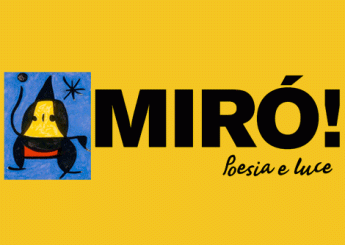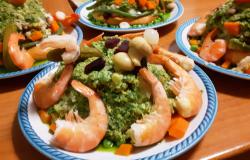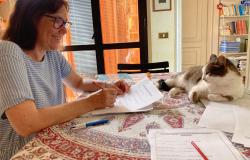A dumpy little penguin-man with a large cheery yellow face, red breeches and a pointed black hat, waves a stick-thin black arm in welcome from the walls of Genoa's distinctive Palazzo Ducale (Doge's Palace). The exhibition Mirò! Poesia e Luce has come to town.
The curator of this exhibition is María Luisa Lax Cacho, and the works exhibited are all from the Fundaciò Pilar i Joan Mirò, Majorca. This is a major exhibition of Mirò's later works, from the 1960's up to the two powerful terracotta heads dated 1981, when the artist was 88 years old.
A film running at the entrance to this exhibition gives information about the artist's early work and reference to his famous “Constellations” and “Blue” paintings, as well as his war statements “Aidez L'Espagne” and “Still Life with Old Shoe”. Mirò's early years were spent moving between his native Catalonia and Paris, combining love of his native land with the stimulating Parisian contact with poets and artists of the early twentieth century. Mirò's works of those years often express an inner calm, a sort of rigorous gaiety in spite of the difficult financial times following upon World War I, and the Spanish Civil war (1936-1939).
The first painting on show is small untitled landscape painting, oil and acrylic on canvas, dated 1908 (when the artist was 15). Mirò later destroyed much of his early work. In fact in 1960 he covered this painting with a piece of newspaper and re-painted the reverse, with the more familiar thick black lines and blobs of bright colour – a long way from the presumably “boring” ochre tints and delicately brushed-in leaves painted by the boy.
The other works displayed are large and striking; black and white predominates, Primary colours are added thickly, by hand or palette-knife, in small areas. Only a few have the blue or fuchsia gouache background that render many Mirò works light and gay. Others are painted directly onto unprepared canvas, plywood, cardboard, chipboard, or even sandpaper, with only a few touches of background paint, not nearly enough to cover the original material.
These are work of the mature Mirò, created after his move to the new studio in Majorca. To have his own studio in Majorca (land of his mother and his wife), was one of his dreams, finally realized in the late 1950's. A model of this studio, designed by his friend, the architect Josep Llui Sert, is displayed with some original furniture, paints, his chair and ornaments including the siurells that so amused and inspired him.
These siurells are small clay statues, whitewashed and with red and green markings, containing a whistle. They were traditionally made by Majorcan women,and these jolly figures are among Mirò's sources of inspiration, along with primitive forms, such as the Altamira cave paintings.
Typical Mirò features are the stars scattered over the firmament of his paintings, skinny and usually black, or the well-defined eyes staring out from the compositions, reminiscent of the eye on a Pharaoh's sarcophagus, or painted on the bow of traditional wooden fishing craft.
Mirò criticized his fellow painters harshly for painting “for the market”, and called his work “anti-painting”. A rolled-up newspaper with some string and a few daubs (Without Title, 1972) meets with some raised eyebrows from visitors. The fact that the majority of works exhibited are “Without Title” and not dated does not help interpretation.

There are a number of monochromatic paintings, sky, earth or sea, horizon – painted in the 1970's, not long after the death of Rothko. They are reminiscent of that artist's works, although the bare horizon landscape had surely been taught to Mirò as a youngster by his teacher Modest Urgell.
Towards the end of the exhibition is another mini-theatre showing excerpts from Robin Lough's documentary “Theatre of Dreams. Mirò”. We see the artist as an amiable elderly gentleman, inclined to chuckle at himself (as when he confirms in an interview that some hand-prints or foot-prints were casual, since he worked on the ground, painting with his hands). We also learn, however, how hard he worked to reach his final result, balancing shapes and colours in anything but a casual manner, often taking years to complete a painting.
A final surprise is the display of Mirò's bronze figures in the ornate Cappella Ducale (Doge's Chapel), a richly decorated baroque chapel, in front of the statue of the Virgin, Queen of the Genoese Republic. The artist would have enjoyed the shock-effect and been amused at a few painted gargoyles smiling down upon his exhibits from amongst angels and cherubs.
***
MIRO'! Poesia e Luce (Poetry and Light)
Exhibition promoted by the City of Genoa and Genoa Palazzo Ducale Cultural Foundation
Produced and Organized by Arthemisia Group and 24 Ore Cultura
in Collaboration with Fondaciò Pilar i Joan Mirò, Majorca, Ajuntament de Palma
In Genoa from 5th October 2012 till 7 April 2013
Opening hours: Mondays from 14.00 – 19.00
Tuesday – Sunday from 9.00 to 19.00
Full price ticket including audioguide: € 13.00
For booking or further information about discounts visit http://www.mostramiro.it/english/








